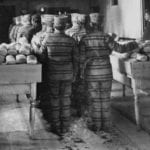 Food
Food  Food
Food  History
History 10 Odd Things Colonial Americans Kept at Home
 Weird Stuff
Weird Stuff 10 Superstitious Beliefs That Once Consumed Entire Cultures
 History
History 10 Bizarre Friendly Fire Incidents in Military History
 Technology
Technology 10 Modern Technologies That Accidentally Imitate Ancient Magic
 Mysteries
Mysteries 10 Mysteries of the Human Genome
 Weird Stuff
Weird Stuff 10 Things So Rare They’ve Only Been Found Once
 History
History 10 Legends Whose Last Moments Undid Their Glory
 Health
Health 10 Futuristic Ideas to Treat Common Medical Problems
 Weird Stuff
Weird Stuff Ten Surreal Attempts to Reverse Baldness
 Food
Food 10 Everyday Foods You Didn’t Know Were Invented by the U.S. Military
 History
History 10 Odd Things Colonial Americans Kept at Home
 Weird Stuff
Weird Stuff 10 Superstitious Beliefs That Once Consumed Entire Cultures
Who's Behind Listverse?

Jamie Frater
Head Editor
Jamie founded Listverse due to an insatiable desire to share fascinating, obscure, and bizarre facts. He has been a guest speaker on numerous national radio and television stations and is a five time published author.
More About Us History
History 10 Bizarre Friendly Fire Incidents in Military History
 Technology
Technology 10 Modern Technologies That Accidentally Imitate Ancient Magic
 Mysteries
Mysteries 10 Mysteries of the Human Genome
 Weird Stuff
Weird Stuff 10 Things So Rare They’ve Only Been Found Once
 History
History 10 Legends Whose Last Moments Undid Their Glory
 Health
Health 10 Futuristic Ideas to Treat Common Medical Problems
 Weird Stuff
Weird Stuff Ten Surreal Attempts to Reverse Baldness
10 Bloody Prison Riots
For anyone who works at a prison, the absolute worst-case scenario is the inmates starting a riot. When a facility is filled to the brim with violent criminals, it’s terrifying to think about them banding together to wreak havoc. The situation is even scarier when these violent criminals are already serving life sentences and have nothing to lose by inflicting violence and taking lives.
10The Battle Of Alcatraz

Since it’s stuck in the middle of San Francisco Bay, Alcatraz Island Federal Penitentiary was considered inescapable and probably seemed an impractical place to stage a riot. However, on May 2, 1946, bank robber Bernard Coy was working as an orderly in C Block when he suddenly attacked the guard responsible for overseeing the prison’s weapons. After taking the man’s key and unlocking the other prisoners from their cells, Coy and five accomplices—Joseph “Dutch” Cretzer, Marvin Hubbard, Clarence Carnes, Sam Shockley, and Miran “Buddy” Thompson—grabbed weapons and managed to disarm all of the guards in the building.
Coy’s plan was to take hostages and hijack the prison’s motorboat to escape. However, in their hasty attempt to unlock the door to the yard, the prisoners accidentally jammed the lock and trapped themselves inside. It wasn’t long before the alarm sounded and the cell block was surrounded.
Cretzer figured the best strategy would be to kill all the hostages, so that they couldn’t testify about who started the riot. He erratically fired shots at the guards, killing one of them and wounding five more. The inmates still refused to surrender and stood off against the authorities outside.
After another guard was killed in a firefight, two platoons of Marines entered to put an end to the crisis. They stormed the prison and rescued the wounded hostages. Coy, Cretzer, and Hubbard retreated to the utility corridors and continued trading shots with the Marines.
Finally, two days after the siege began, all three convicts were shot to death, and the “Battle of Alcatraz” was over. Carnes received a life sentence for his role in the riot, while Shockley and Thompson were executed.
9The Carandiru Massacre

One of the most violent and horrific responses to a prison riot occurred in 1992 at Carandiru Penitentiary in Sao Paulo, Brazil. At the time, Carandiru was the largest prison in Latin America, and it was horribly overcrowded. Even though the facility was built to house 3,500 inmates, its population had ballooned to 7,300. Because violence was ready to explode at any moment, the facility was nicknamed “the Powder Keg.”
On the afternoon of October 2, a dispute between rival drug-trafficking gangs at Carandiru escalated into a full-scale riot. The inmates took control of the facility, and authorities made no attempt to negotiate with them. Instead, the military police immediately swept in.
Three hours after the riot started, over 300 military policemen opened fire. They killed 111 prisoners and wounded 35 more. Even though 22 officers were wounded during the riot, none of them were killed, which strongly suggests they used unjustifiable violence. In fact, eyewitnesses claimed that many of the prisoners who were shot had been hiding in their cells or trying to surrender. Since these victims presented no threat to the police, the Carandiru Massacre was seen as a major human rights violation.
The commanding officer, Colonel Ubiratan Guimaraes, was convicted of using excessive force, but the conviction was soon overturned. However, in recent years, indictments have been handed down to many of the policemen involved in the Carandiru Massacre. As of 2014, a total of 73 officers have been convicted of murder for their roles. Most of them have received lengthy symbolic sentences, some as long as 624 years, even though the longest prison sentence anyone in Brazil can legally serve is 30 years.
8The Atlanta Cuban Riots

In November 1987, two separate prisons in the southern United States rioted for the exact same reason.
That month, the US had signed an immigration agreement to deport 2,500 Cuban nationals who had entered the country illegally. These Cubans had been incarcerated at a federal detention center for illegal aliens in Oakdale, Louisiana and at the US Federal Penitentiary in Atlanta.
Since the Federal Bureau of Prisons received little notice about the immigration agreement, they were ill prepared to deal with the hostile reactions. On November 21, only one day after the agreement was signed, over 1,000 Cuban detainees at Oakdale made a mass escape attempt. When they were unsuccessful, they seized control of the facility, taking 28 hostages.
Word about the Oakdale riot soon reached the penitentiary in Atlanta. On November 23, 1,400 Cuban inmates rioted and took 75 hostages. During the chaos, a guard shot one of the inmates fatally.
Both prison standoffs lasted more than a week, with the Cubans demanding assurances that they would not be deported. Finally, on November 29, eight days after the siege began, the inmates at Oakdale surrendered after signing an agreement to ensure that each Cuban would receive a fair hearing. On December 4, the inmates in Atlanta agreed to a similar arrangement before surrendering and releasing their hostages.
Over the next few years, approximately 1,000 of the Cuban nationals were deported back to their home country, but the rest were allowed to remain in the US.
7The Battle Of Qala-i-Jangi

In November 2001, with the events of September 11 still fresh in everyone’s minds, the Northern Alliance in Afghanistan captured 1,000 members of the Taliban and Al-Qaeda. They took the prisoners to the Qala-i-Jangi camp as enemy combatants but neglected to thoroughly search all of them before bringing them into the facility.
Some prisoners smuggled grenades inside. They used them to stage a suicide attack, and two Northern Alliance guards died—but the worst was yet to come.
On November 25, two American CIA officers arrived at Qala-i-Jangi to interrogate the prisoners. During one of the interrogations, a Taliban prisoner grabbed an AK-47 from a guard and killed an officer, Johnny Michael Spann. The prisoners then overpowered the guards and took over the facility.
American and British Special Forces showed up to assist Northern Alliance fighters and spent the week engaging in all-out war with the prisoners. Within the next two days, the combined military forces had killed many of the prisoners and recaptured a large portion of the facility. However, over 100 prisoners retreated to a basement and remained there for the next four days, continuing to resist.
Northern Alliance soldiers tried to drive the prisoners out by pumping oil into the basement and setting it on fire. When that didn’t work, they filled the basement with freezing irrigation water. Rather than drown, the remaining prisoners finally surrendered. Out of the 1,000 prisoners at the facility, only 86 survived the uprising.
6Montana State Prison

For nearly a century, Montana State Prison was an iconic institution in the town of Deer Lodge, but by the time the 1950s rolled around, it had greatly deteriorated. Then came a riot on the afternoon of April 16, 1959, instigated by veteran convict Jerry Myles and his 19-year-old lover, Lee Smart. George Alton, a fellow inmate who worked in the prison garage, had access to gasoline, so the trio doused a guard with gas and made torches from mop handles and rags. They threatened to light the guard on fire, and he surrendered his rifle and keys to them.
The trio released the other inmates from their cells, and the mob took all the guards hostage. The inmates then made their way to the office of Deputy Warden Ted Rothe. Smart killed him with a shotgun blast to the chest.
Warden Floyd Powell contacted the governor, who called in the Montana National Guard, launching a 36-hour armed standoff. During that time, Myles used a bullhorn to speak to the media, claiming that he’d incited the riot to improve conditions at the prison. In actuality, Myles was buying time to orchestrate a new escape plan, as the inmates were digging a tunnel under the wall near the northeast tower. However, the escape attempt was doomed. During the early morning of hours of April 18, the National Guard stormed the prison.
Most of the inmates surrendered peacefully, and the hostages were rescued unharmed. But Myles and Smart continued to exchange fire with the guards, until Myles finally shot his lover and then turned the gun on himself.
5The Civilian Riot

It’s hard to imagine ordinary citizens rioting at a prison to protest inmate treatment, considering they have so many other avenues for making their voices heard. Yet such an event actually occurred at Auburn State Prison in New York in 1821. The warden of this facility was Elam Lynds, a notoriously brutal taskmaster who believed in severe punishment and often flogged prisoners. Much of the surrounding community openly disapproved of Lynds’s harsh methods, and the sentiment spread to his own staff.
One day, Lynds fired three guards for refusing to whip some prisoners, and he brought in a local blacksmith named Jonathan Thompson to perform the task. That evening, Thompson left the prison and was surprised to find himself confronted by an unruly mob of vigilantes. The mob was so angry about the flogging that they tarred and feathered him and paraded him outside the prison on a rail.
When the inmates saw what was going on, they ran wild and set some fires. Warden Lynds got the situation under control, arresting four mob members for instigating the riot.
In the grand scheme of things, the riot was relatively minor, but it had some good effects—for Lynds. He used the incident as an example of why severe punishment was necessary to control his inmates. Auburn State Prison then became an even more brutal place.
4The Lucasville Prison Riot
In 1993, a riot took place at the Southern Ohio Correctional Facility in Lucasville, and three separate prison gangs—the Aryan Brotherhood, the Black Gangster Disciples, and the Sunni Muslims—formed a very unlikely alliance.
Tensions had risen when the Ohio Department of Health mandated that all inmates be vaccinated for tuberculosis. This decision prompted outrage from the Sunni Muslims, who said that vaccinations violated their religious beliefs. The Muslims joined forces with the other two gangs, who all put their personal differences aside to instigate a riot on Easter Sunday, April 11. A group 450 prisoners took over the facility’s L Block, taking eight guards hostage.
The standoff lasted 11 days. On April 15, the authorities cut the facility’s power and water, and the inmates responded by killing a hostage, guard Robert Vallandingham. Throughout the siege, a total of nine inmates were also killed. The prisoners perhaps used the riot as an excuse to take out snitches.
On April 21, authorities negotiated a settlement for the prisoners’ surrender, but the gang leaders were concerned about an inmate named David Sommers, who’d handled phone calls during the negotiations. Thinking Sommers had overheard too much incriminating information, they killed him just before surrendering.
In spite of their attempts to cover their tracks, five inmates were sentenced to death for murders committed during the riot.
3The Qasr Rescue Mission

On February 12, 1979, an angry mob stormed Qasr Prison in Tehran, Iran, instigating a heated riot that freed all 11,000 prisoners inside. The mob had no idea that their entire riot may have been orchestrated as part of a covert American rescue operation.
This incident came on the heels of the Iranian Revolution, in which the Shah of Iran had been overthrown and replaced by Ayatollah Khomeini. Two months before the riot, American information technology company Electronic Data Systems (EDS) had been operating in Iran, installing computer systems for the government. Once the revolution started, EDS executives Bill Gaylord and Paul Chiapparone were arrested on corruption charges.
The founder of EDS happened to be future US presidential candidate Ross Perot. When Perot had no luck negotiating the release of his two executives, he turned to some retired military operatives to launch a rescue mission called “Operation Hotfoot.” Then while the mission was being prepared, Gaylord and Chiapparone were both transferred to Qasr Prison. Since no ordinary military operation could spring them from such a facility, Perot dreamed up another idea and sought the assistance of an Iranian EDS employee named Rashid.
On the evening of February 12, Rashid told a large mob of pro-Khomeini revolutionaries that Qasr Prison was holding prisoners of the Shah. Soon after, revolutionaries stormed the facility, directly responding to Rashid, according to Perot and Chiapparone. Throughout all the chaos, Rashid was able to guide Gaylord and Chiapparone out of the prison undetected. They soon joined up with Perot’s team of operatives, who helped the two executives escape the country.
2Strangeways Prison

One of the longest prison riots in history took place at Strangeways Prison in Manchester, England. In 1990, the 1,647 prisoners there frequently complained about the poor conditions and needless brutality. When over 300 prisoners showed up for a Sunday morning service at the prison chapel on April 1, tensions were high.
During the sermon, inmate Paul Taylor took the microphone and shouted, “Let’s take the prison.” The prisoners threw themselves on the guards and then climbed through the chapel roof. They infiltrated the prison’s other wings, releasing enough men to take over the entire facility. As the day wore on, most prisoners surrendered, but by the next morning, over 200 of them still controlled a large portion of the prison and had taken several guards hostage.
Many prisoners protested by occupying the prison’s rooftop. They contacted the media to outline their grievances about Strangeways, providing a list of demands. As the siege wore on and negotiations continued, more prisoners surrendered, but it would take 25 days for the entire ordeal to end. During the month, the Strangeways riot inspired smaller riots and protests in other prisons throughout Great Britain.
Finally, on the evening of April 25, only five prisoners remained—including instigator Paul Taylor. They surrendered, descending from the rooftop. Just one inmate and one guard died in the riot, but there were a total of 194 injuries. In the end, the riot did lead to a public inquiry and a report published by Lord Woolf, who recommended major reforms to the prison system.
1The Attica Prison Riot

Perhaps the world’s most infamous prison riot took place in 1971 at Attica Correctional Facility in New York. This was another case of an overcrowded prison suffering from high tensions, but the final impetus for the riot came from a series of misunderstandings.
On September 8, a guard mistakenly thought that two inmates were fighting and took them away for punishment. False rumors spread that the inmates were being tortured. The following morning, prisoners scuffled with guards until things finally reached a breaking point. Approximately 1,000 inmates took over a large section of the prison, causing much destruction and taking 42 staff members hostage.
A large percentage of the inmates at Attica were minorities and believed the racist warden and his guards inflicted needless brutality on them. They wanted the federal government to take control of the prison and improve conditions. The standoff lasted four days as negotiations went back and forth. However, New York Governor Nelson Rockefeller refused to visit the prison to speak with the inmates and also refused their demand to receive amnesty for the riot.
Finally, on the morning of September 13, Rockefeller ordered the state police and the National Guard to take back the prison. After tear gas was dropped into the yard, the authorities stormed in. When the siege ended, 10 hostages and 29 inmates had lost their lives. It was later determined that all of the hostages were killed by friendly fire.
The decision to storm the prison was highly controversial and would tie up the courts for decades. The families of the victims eventually collected substantial financial settlements for the civil rights violations committed during the re-taking of Attica.
Robin Warder is a budding Canadian screenwriter who has used his encyclopedic movie knowledge to publish numerous articles at Cracked.com. He is also the co-owner of a pop culture website called The Back Row and recently worked on a sci-fi short film called Jet Ranger of Another Tomorrow. Feel free to contact him here.








